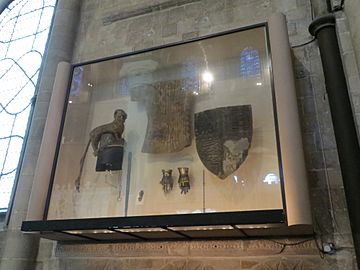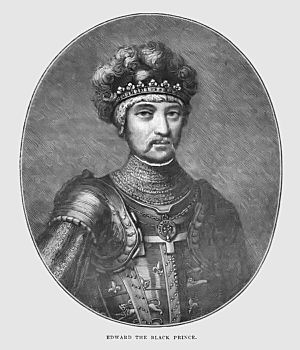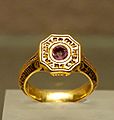Edward the Black Prince facts for kids
Quick facts for kids Edward the Black Prince |
|
|---|---|
| Prince of Wales and of Aquitaine Duke of Cornwall |
|
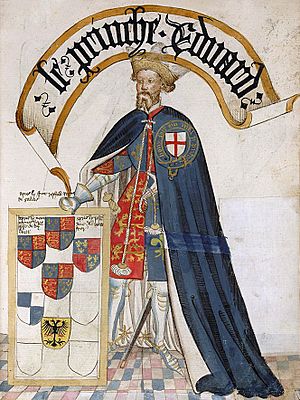
Edward the Black Prince as a Knight of the Garter, 1453, illustration from the Bruges Garter Book, British Library.
|
|
| Born | 15 June 1330 Woodstock Palace, Oxfordshire, England |
| Died | 8 June 1376 (aged 45) Westminster Palace, London, England |
| Burial | 29 September 1376 Canterbury Cathedral, Kent |
| Spouse | |
| Issue more... |
|
| House | Plantagenet |
| Father | Edward III, King of England |
| Mother | Philippa of Hainault |
Edward of Woodstock, often called the Black Prince, was born on June 15, 1330, and died on June 8, 1376. He was the oldest son of Edward III of England, who was the King of England. Edward was supposed to become king after his father, but he passed away before him. Because of this, his son, Richard II, became king instead.
Even though he never became king, Edward was a very successful military leader during the Hundred Years' War. People at the time thought he was a perfect example of chivalry and one of the greatest knights of his era. He was known for his bravery and skill in battle.
Contents
Edward the Black Prince: His Life Story
Edward was the first son of Edward III of England and Queen Philippa. He was born at Woodstock Palace in Oxfordshire, England, on June 15, 1330.
His father, Edward III, became king when he was only 14 years old in 1327. This happened after his own father, Edward II of England, was removed from the throne. Edward III and Queen Philippa had 13 children, and Edward was their oldest.
Edward III had started a war with Scotland. In 1333, Edward III won a big victory against the Scots at the Battle of Halidon Hill. This helped England regain control and made the king very popular.
As a young prince, Edward was given important titles. In 1333, he became the Earl of Chester. In 1337, he was made the Duke of Cornwall, which was the first time someone was given the title of duke in England. He also served as a temporary ruler of England when his father was away in 1338, 1340, and 1342. In 1343, he was named Prince of Wales. His father knighted him in 1346.
Edward's Military Campaigns
In 1346, Prince Edward led the main part of the army at the Battle of Crécy. His father purposely let him lead, and Edward helped win the battle. He also joined his father's army in 1349 during the Battle of Calais.
In 1355, Edward was put in charge of the king's forces in Gascony, a region in France. He led a military raid, called a chevauchée, into Aquitaine. During this raid, his army took goods from towns like Avignonet and Castelnaudary, and burned parts of Carcassonne and Narbonne.
The next year, in 1356, he led another raid through areas like Auvergne and Limousin. He met the French army near Poitiers. Edward offered peace terms to King John II of France, but he refused to surrender himself. This led to the Battle of Poitiers, where Edward's army completely defeated the French and captured King John.
After this big victory, Edward returned to England in 1357. In 1360, he helped negotiate the Treaty of Brétigny, which was a peace agreement between England and France. In 1362, he was made the Prince of Aquitaine and Gascony.
In 1367, Edward fought another important battle, the Battle of Nájera, in Spain. He defeated Henry II of Castile, who was a rival king. However, Edward faced financial problems and health issues after this campaign.
In 1368, Edward tried to raise money by introducing a new tax in Aquitaine. This made some of the local nobles unhappy.
His Final Years
Edward faced a lot of sadness when his oldest son, Edward of Angoulême, passed away in 1371. His own health was getting worse, and his doctor told him to go back to England.
Prince Edward returned to England in 1371. The next year, he gave up his title as Prince of Aquitaine and Gascony. He became very ill with a sickness called dysentery.
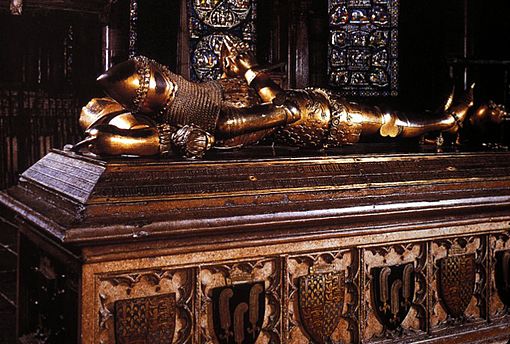
Edward knew he was dying. He made sure to leave gifts for his servants in his will and said goodbye to his father, King Edward III. He asked his father to protect his young son, Richard.
Edward died at the Palace of Westminster on June 8, 1376. He was buried with a grand ceremony at Canterbury Cathedral on September 29. His will gave specific instructions for his funeral and tomb. His armor pieces, like his surcoat, helmet, shield, and gauntlets, were hung above his tomb. Today, replicas are there, and the original items are kept safely in a display cabinet.
Edward's Family
Edward married his cousin, Joan, Countess of Kent, on October 10, 1361. She was the daughter of Edmund of Woodstock, 1st Earl of Kent.
Edward and Joan had two sons, both born in Aquitaine:
- Edward, born in 1364. He died in 1371, before his father returned to England.
- Richard, who later became king after his grandfather, Edward III.
Edward also became a stepfather to Joan's children from her previous marriage:
Before his marriage, Edward had other children, including:
- Sir Roger Clarendon
- Sir John Sounders
Why Was He Called the Black Prince?
Edward is famously known as the "Black Prince." The first time this name was written down was by a historian named John Leland in the 1530s, about 165 years after Edward died. This suggests the name was already commonly used by then.
No one is completely sure why he was called the Black Prince, but there are two main ideas:
- His Armor or Shield: One idea is that he wore black armor or had a black shield. While we know he had a special "shield for peace" that was black, there's no strong proof he always wore black armor. Some historians think it might have been a tradition in plays or ceremonies later on to show him in black armor.
- His Reputation: Another idea is that the name came from his fierce reputation, especially among the French. Some French writers called him one of the "black boars" because of how aggressive he was in battles. There are even old stories in southern France about "L'Homme Noir" (The Black Man), referring to an army leader who passed through.
Even though the exact reason is a mystery, the name "Black Prince" has stuck with him throughout history.
Images for kids
-
Signet ring of the Black Prince found in Montpensier, France in 1866. Louvre, Paris.
See also
 In Spanish: Eduardo de Woodstock para niños
In Spanish: Eduardo de Woodstock para niños


